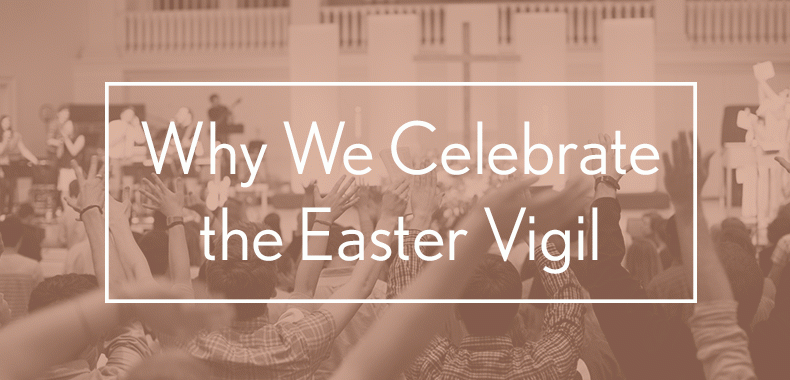The resurrection of the Lord Jesus Christ is at the very core of our faith as Christians. Thus, the Apostle Paul teaches, “If you confess with your mouth that Jesus is Lord and believe in your heart that God raised him from the dead, you will be saved” (Romans 10:9, ESV). Likewise, Paul clearly states that “If Christ ha[d] not been raised, [our faith would be] futile” (1 Corinthians 15:17, ESV). For this reason, Christians from the very earliest days of the Church have gathered together on the first day of the week, the day that Jesus rose from the dead, to celebrate and proclaim the mystery of his death and resurrection.
It was from this same resurrection perspective that Jewish Christians, who continued to celebrate the Passover each year, came to understand the deeper meaning of that ancient feast, proclaiming, “Christ, our Passover lamb, has been sacrificed” (1 Corinthians 5:7, ESV). Over time, even Christians who did not come from a Jewish background began to celebrate the annual “Christian Passover” we now call Easter. While the Jewish Passover (the 14th day of the month of Nissan) can fall on any day of the week, Christians chose to celebrate this annual feast on a Sunday, thereby underscoring its connection with the weekly celebration of the Lord’s resurrection.
The Apostle Paul also teaches that we personally share in Christ’s resurrection by sharing in his saving death, stating in Romans 5:6, “If we have been united with him in a death like his, we shall certainly be united with him in a resurrection like his.” He goes on to explain that when we’re baptized into Jesus’ life, we’re also baptized into his death (Romans 6:3, ESV). It is only natural, then, that the celebration of Easter is closely associated with the celebration of the sacrament of baptism.
Those to be baptized on Easter prayed and fasted to prepare themselves during a 40-day season we now call “Lent.” The culmination of this period of intense preparation was a night watch or “Vigil” of scripture reading and prayer that immediately preceded baptism and the celebration of Holy Eucharist on Easter Sunday.
This pattern is faithful to the example given to us by Jesus himself on the first Easter. Luke 24:13–24 tells us of two disciples of Jesus, traveling together to a village near Jerusalem called Emmaus. On their journey they were joined by an apparent stranger. They took this opportunity to share with their newfound companion the profound discouragement they felt at the death of their teacher just three days earlier, and their confusion at strange reports of an empty tomb and the appearance of angels. Their still-unknown companion, who was none other than the risen Lord Jesus himself, replied:
O foolish ones, and slow of heart to believe all that the prophets have spoken! Was it not necessary that the Christ should suffer these things and enter into his glory?” And beginning with Moses and all the Prophets, he interpreted to them in all the Scriptures the things concerning himself.
When they reached the village, they urged their companion, whom they still did not recognize, to stay with them for the night. It was only then, as they shared a meal together, that they finally recognized the risen Lord:
When he was at table with them, he took the bread and blessed and broke it and gave it to them. And their eyes were opened, and they recognized him. And he vanished from their sight. They said to each other, “Did not our hearts burn within us while he talked to us on the road, while he opened to us the Scriptures? (ESV)
Easter Vigil is an invitation to experience for ourselves what those disciples experienced on the Road to Emmaus the evening of the very first Easter. Like them, we are led through a series of passages from the Old Testament, beginning with Moses (Genesis, Exodus) and continuing through the prophets (Isaiah, Ezekiel, Zephaniah), while our hearts burn within us as the veil is removed from our eyes (2 Corinthians 3:16) and we see revealed in each passage the saving work of the one who died for us and “on the third day rose again, according to the Scriptures” (Nicene Creed).
We’re also invited to recognize the presence of the risen Lord Jesus himself among us, in the breaking of the bread of Holy Eucharist.
Jesus himself tells us he is “the Alpha and the Omega, the first and the last, the beginning and the end” (Revelation 22:13, ESV). The readings of the Easter Vigil remind us that the One who is the same yesterday, today, and forever (Hebrews 13:8) has been at work since the very beginning of Creation (“For by him all things were created, in heaven and on earth, visible and invisible, whether thrones or dominions or rulers or authorities—all things were created through him and for him” Colossians 1:16, ESV). God’s promise to Israel (“You shall be to me a kingdom of priests and a holy nation,” Exodus 19:6, ESV), has been gloriously fulfilled in us. We are now a “chosen race, a royal priesthood, a holy nation” (1 Peter 2:9, ESV). May the resources in this booklet help us to prepare ourselves to be faithful to that call.
Rev. Canon Dr. Stephen J. Gauthier
Assisting Priest at Church of the Resurrection
Canon Theologian for the Anglican Diocese of the Upper Midwest
For teachings, paintings, and discussion questions from the Easter Vigil service Scripture readings, click here for our God’s Saving Deeds Bible Study.



